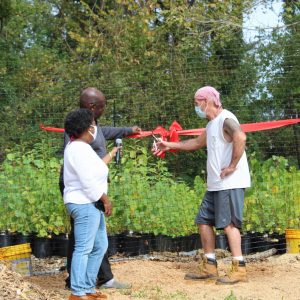BALTIMORE – Just off Frederick Avenue, Stillmeadow Community Fellowship, a small, predominantly Black church five miles west of downtown and surrounded by the Tremont, Westgate and Beechfield neighborhoods, has embarked on a project it hopes will transform its community.
Guided by the vision of the Rev. Michael S. Martin, senior pastor, Stillmeadow has begun to revamp an unkempt piece of property next to the church. It was known to residents as simply “the woods,” 10 acres of dying and decaying trees that nobody wanted.
“I kept hearing the urban legend of ‘the woods’,” Martin said in an interview with Capital News Service. “It didn’t really mean anything to anybody.”
It was so low of a priority, Martin said, that “it was a year before somebody walked me through the woods.”
The church tried to sell the property, but there were no legitimate takers.
So, Martin and the church decided to rehabilitate the land.
What began as a seemingly impossible task has grown far beyond Martin’s initial plans. The church’s effort to reclaim the area has attracted help from colleges and universities, numerous community organizations, hundreds of volunteers and the U.S. Department of Agriculture Forest Service, which has poured hundreds of hours and thousands of dollars into the project.
“It has been transformational,” Martin said.
The project began in 2018, after heavy rains in May flooded communities in parts of west metropolitan Baltimore. Scores of homes and businesses were damaged or destroyed, numerous people were injured and one man drowned.
Ellicott City received most of the flood news coverage, including television crews from NBC, the Weather Channel and Telemundo. Martin’s community, which was likewise impacted, was barely mentioned.
“Everyone knows Ellicott City, but they don’t know eight feet of water was rushing down Frederick Avenue,” said Martin, who came to the church 17 months before the flood. “It impacted about 140 homes. That’s almost a sad secret in our city and beyond.
“That’s when we started. We became the headquarters for all the city, state and even federal response to those 140 homes.”
The assistance efforts reintroduced the 32-year-old church to the surrounding community, Martin said, and began a sustained effort by the church to improve the neighborhood. The efforts to reclaim the forest is an outgrowth of that commitment.
The wooded area, which stretches west from the church just north of Frederick Avenue to Boswell Road, consists of a creek, walking trails and extensive amounts of brush.
Numerous dead ash trees have been removed. They were killed by emerald ash borers, an invasive beetle species whose larvae feed on the inner bark of the trees, crippling their ability to transport water and nutrients.

“We cut down over 100 trees and we’ve planted now, close to 2,000 saplings,” Martin said, explaining the ongoing work.
A variety of groups and organizations worked alongside the church, including non-profits like Baltimore Green Space, Blue Water Baltimore and Interfaith Partners for the Chesapeake.
Other organizations include Bee Friendly Apiary, The National Audubon Society, and the National Wildlife Federation.
Students from the University of Delaware, Morgan State University, Coppin State University and the University of Maryland, Baltimore County, have volunteered throughout the project. Community members and high school students in the area have also played a part.
While the coronavirus pandemic slowed many projects around the nation and in Maryland, it had minimal effect on the church’s effort, Martin said.
“In these two years of covid, we’ve had 8,000-plus volunteer hours for the park and for helping the community,” Martin said. “Fortunately, forests are outside. So, it was always a lot safer and a lot more conducive to people being able to volunteer.”
The complete rehabilitation of the park is a 30-year project, according to the United States Department of Agriculture’s Forest Service, which is overseeing the project.
“The time frame is more about monitoring,” said Nancy Sonti, a research ecologist with the Forest Service. “The task changes over the course of the 30 years. The park provides opportunities for education and training.”
Beginning last year, the Forest Service began a three-year commitment of $90,000 annually to the restoration effort.
Morgan Grove, a research forester with the Forest Service, praised the work of the volunteers.
“The volunteers did a phenomenal job of moving the trees away from the original locations,” Grove said. “It was brutal work.”
Even small children got in on the action, helping out closer to the ground, Grove said.
“We figured out how to match the skill to the task,” he said. “We had kids in pull-ups help planting trees.”
Grove said the community building and interactions across different groups of people to make the effort work also held immense value.
“In a way, Stillmeadow is kind of like ‘Stone Soup,’” Grove said, referring to the European folk story in which an impoverished community learns that by each person adding a little to a community meal, everyone could eat.
“There’s been building a forest community, which is ecological, but there’s also building the social community,” he said.
Work continues on the forest, which was christened PeacePark with a ribbon-cutting in Oct. 2020. People are already using the park, Martin said.

“Stillmeadow PeacePark is officially, formally open,” Martin said. “People use the trails. People go wild looking at the pond. We’re going to be releasing some bluegills (fish) in the pond in May. The walking paths are up and running.”
When the process began, Martin said there were some community concerns about the space being turned into a playground area with more asphalt and metal. He said that was never the church’s intention.
“It needed to stay as natural as it was,” he said. “It just needed to become healthy.”
– 30 –

You must be logged in to post a comment.